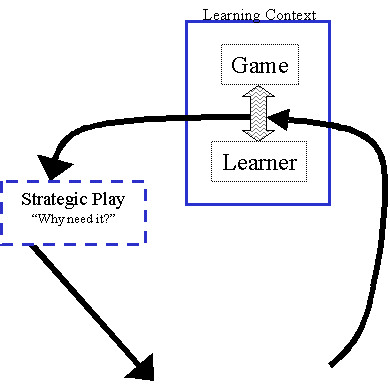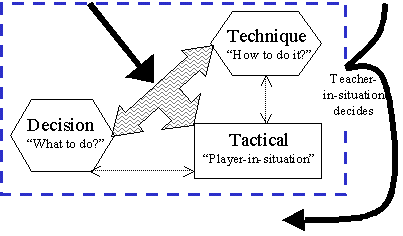|
Lesson
Plan model for a TGfU lesson |
||||
|
Content |
Drag cursor onto model for insights on three
phases of a lesson |
Teacher |
||
| Planning the
content for a TGfU lesson requires an understanding of how the play of
the game draws on off-the-ball movements, on-the-ball skills within a
tactical awareness of how to play. The following articles address this content challenge:
The main body of the lesson should develop content in
progressive way from simple tactic and skill challenge to more complex
using of multiple skills that feed into a game and from a game
played. Students should be able to progress at their own level
based on achieving goals set by the teacher, i.e. "if you can do it
10 times in a row try..." Game play can be co-operative,
competitive or to a scoring system either for whole class or as a choice
between players. See article: The culminating game
should connect ideas from the class together so that students feel a
sense of purpose to their practice and hopefully a sense of
improvement. The game performance assessment instrument (GPAI),
offers a way to make this learning more recognized and authentic.
See the following along with 4Rs article for ideas: |
  (1) (1)
(2)
(3) |
The teaching
process within a TGfU approach focuses on creating learning situations
that cause the student to learn. This situated learning means that
the game form created for the students should initially be one
they can play but involves a strategic focus that feeds into the main
body of the lesson. A game could be simply keeping the ball going
individually or with a partner, or simple pair/small group tag
game. The focus is gradual increase in physical intensity and
cognitive challenge. See ideas in following articles:
In the main body of the lesson the teacher is teaching
a task progression based on the basic task model that challenges the
students conceptual tactical understanding of the game as well as their
skill development. A new game could be developed or the
introductory activity could lead to a skill progression leading to a
more develop game. The teacher has to read the students play and
practice (1) how to do a skill or, what to do in the game, or, in a game
(2) how to play in a game to get more success. See pace, force and
time ideas in: The culminating game of a lesson a critical point to
assess how wel students have learned and how well they are starting to
play. The game should be an extension of the games played in the
main body of the lesson and should include questioning that connects
back to the lesson and a meaningful closure that connects back to the
main tactical concepts and skills taught in the lesson. the
following article highlights this progression to a culminating game.
|
||
